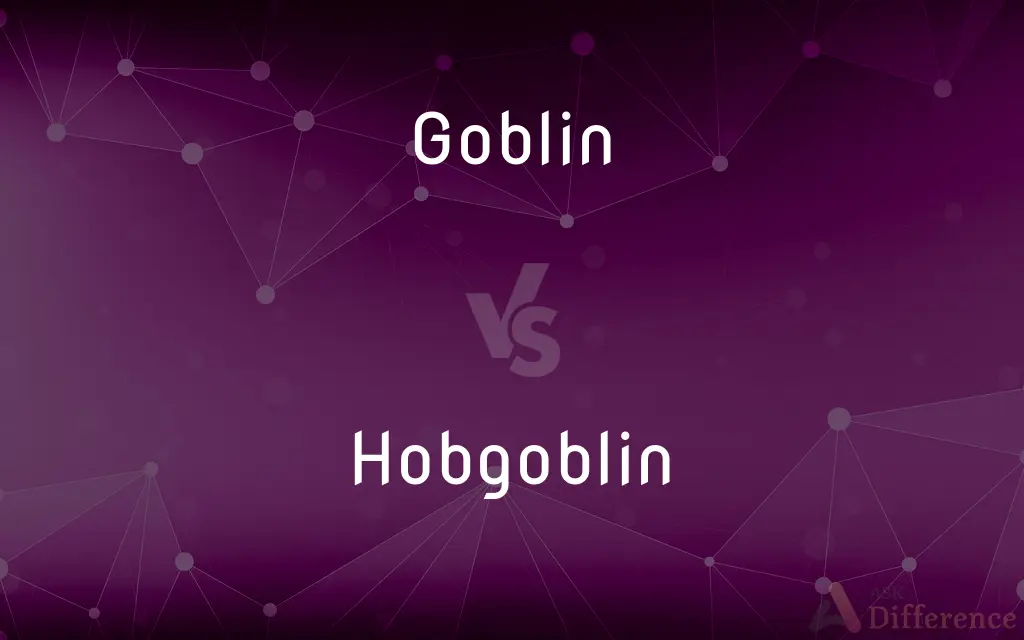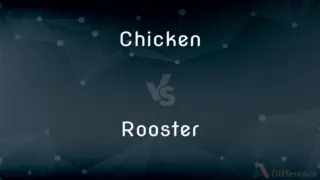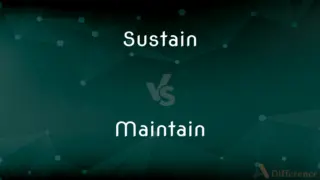Goblin vs. Hobgoblin — What's the Difference?
By Tayyaba Rehman — Updated on August 5, 2024
A goblin is a mischievous, grotesque, small creature in folklore, often causing harm. A hobgoblin is considered larger, less malicious, sometimes even benevolent, often depicted as a guardian spirit.

Difference Between Goblin and Hobgoblin
Table of Contents
ADVERTISEMENT
Key Differences
A goblin is a creature originating from European folklore, often depicted as a small, grotesque, and malicious being. Goblins are traditionally shown as green or brown, with a proclivity for mischief and mayhem, and often associated with hoarding treasures. Conversely, a hobgoblin is generally perceived as a variant of a goblin but is usually larger and less malevolent. Hobgoblins are often depicted as more tempered beings, sometimes even with a sense of morality and a disposition to guard or protect.
The differentiation between a goblin and a hobgoblin primarily lies in their disposition and their portrayal in folklore and literature. While goblins are almost universally portrayed as mischievous and harmful entities, hobgoblins have a more nuanced depiction, with some narratives portraying them as benign or even helpful entities. The diversity in their portrayal showcases the rich and varied tapestry of folklore and mythology, reflecting different cultural perceptions and interpretations of these entities.
In summation, both goblin and hobgoblin are integral components of folklore and fantasy, representing different aspects of the moral and mythical spectrum. Goblins symbolize mischief and chaos, and hobgoblins represent a more balanced and sometimes protective force, reflecting the diverse ways in which different cultures perceive and interpret the unseen and the unknown.
Comparison Chart
Size
Typically small
Generally larger
Disposition
Malicious and mischievous
Less malicious, sometimes benevolent
ADVERTISEMENT
Role in Folklore
Symbolizes chaos and disorder
Often depicted as a guardian or protector
Portrayal
Grotesque, often harmful creature
More tempered, complex moral spectrum
Associations
Often associated with hoarding treasures
Associated with protection or guardianship
Compare with Definitions
Goblin
A mythical creature usually represented as a diminutive, unpleasant entity.
The child feared a goblin was hiding under his bed at night.
Hobgoblin
A character in folklore symbolizing a balanced and sometimes protective force.
The presence of the hobgoblin ensured the harmony and balance of the natural elements around the sacred grove.
Goblin
A small, often malicious being associated with chaos and mischief.
In the story, a goblin caused havoc in the peaceful village.
Hobgoblin
A larger, less malicious variant of a goblin, sometimes portrayed as a guardian.
The hobgoblin watched over the ancient ruins, protecting them from intruders.
Goblin
A grotesque, mischievous creature found in folklore.
The goblin snickered as he stole the gold coins from the unwatched pouch.
Hobgoblin
A creature in folklore, often seen as more tempered and moral than goblins.
The hobgoblin, offended by the traveler’s rudeness, decided to play a harmless prank on him.
Goblin
A fantastical being known for its destructive and disorderly nature.
The forest was said to be inhabited by goblins, deterring villagers from entering it.
Hobgoblin
A mythical entity with a complex moral spectrum, often aiding or hindering humans.
The villagers left offerings for the hobgoblin, hoping for his protection against evils.
Goblin
A folklore character symbolizing disruption and malevolence.
In the game, defeating the goblin yielded valuable treasures.
Hobgoblin
A hobgoblin is a spirit (creature) of the hearth, typically appearing in folklore, once considered helpful but since the spread of Christianity has often been considered mischievous. Shakespeare identifies the character of Puck in his A Midsummer Night's Dream as a hobgoblin.
Goblin
A goblin is a monstrous creature that appears in the folklore of multiple European cultures, first attested in stories from the Middle Ages. They are ascribed various and conflicting abilities, temperaments and appearances depending on the story and country of origin.
Hobgoblin
An ugly, mischievous elf or goblin.
Goblin
A grotesque elfin creature of folklore, thought to work mischief or evil.
Hobgoblin
An object or a source of fear, dread, or harassment; a bugbear
"A foolish consistency is the hobgoblin of little minds" (Ralph Waldo Emerson).
Goblin
One of various hostile supernatural creatures, now especially (fantasy literature) a malevolent and grotesque diminutive humanoid, often associated with orcs or trolls.
Hobgoblin
A small, ugly goblin that makes trouble for humans.
Goblin
An evil or mischievous spirit; a playful or malicious elf; a frightful phantom; a gnome.
To whom the goblin, full of wrath, replied.
Hobgoblin
(by extension) A source of dread, fear or apprehension; a bugbear.
Goblin
(folklore) a small grotesque supernatural creature that makes trouble for human beings
Hobgoblin
A frightful goblin; an imp; a bugaboo; also, a name formerly given to the household spirit, Robin Goodfellow.
Hobgoblin
(folklore) a small grotesque supernatural creature that makes trouble for human beings
Hobgoblin
An object of dread or apprehension;
Germany was always a bugbear for France
A foolish consistency is the hobgoblin of little minds
Hobgoblin
A being sometimes seen as benevolent, with a disposition to guard or protect.
In the tale, the kind hobgoblin helped the lost child find his way home.
Common Curiosities
What is a Goblin?
A goblin is a small, grotesque creature in folklore, known for mischief and malevolence.
Are Goblins and Hobgoblins real?
Goblins and hobgoblins are mythical creatures from folklore and are not considered real.
What is a Hobgoblin?
A hobgoblin is typically a larger, less malicious variant of a goblin, sometimes seen as a guardian spirit.
Are Goblins always malicious?
Goblins are typically portrayed as malicious and mischievous in folklore.
How are Goblins usually depicted?
Goblins are usually depicted as small, grotesque, green or brown creatures.
Can Hobgoblins be benevolent?
Yes, hobgoblins are often depicted as less malicious and can even be benevolent in some stories.
Do Goblins symbolize chaos?
Yes, goblins often symbolize chaos and disorder in folklore.
Are Hobgoblins protective?
Hobgoblins are often depicted as protective or guardians in various stories.
Do Goblins hoard treasures?
Yes, in many stories, goblins are associated with hoarding treasures.
Can Hobgoblins be guardians?
Yes, hobgoblins are often portrayed as guardians or protectors in folklore.
Are Hobgoblins depicted as morally complex?
Yes, hobgoblins are often depicted with a more nuanced and complex moral spectrum compared to goblins.
Are Goblins and Hobgoblins from European folklore?
Yes, both goblins and hobgoblins primarily originate from European folklore.
Is the depiction of Goblins uniform across cultures?
No, the depiction of goblins can vary widely across different cultures and stories.
Can Goblins and Hobgoblins appear in modern fantasy literature?
Yes, goblins and hobgoblins are common characters in modern fantasy literature and games.
Do Hobgoblins aid humans in some stories?
Yes, in some stories, hobgoblins are depicted as aiding or protecting humans.
Share Your Discovery

Previous Comparison
Chicken vs. Rooster
Next Comparison
Sustain vs. MaintainAuthor Spotlight
Written by
Tayyaba RehmanTayyaba Rehman is a distinguished writer, currently serving as a primary contributor to askdifference.com. As a researcher in semantics and etymology, Tayyaba's passion for the complexity of languages and their distinctions has found a perfect home on the platform. Tayyaba delves into the intricacies of language, distinguishing between commonly confused words and phrases, thereby providing clarity for readers worldwide.













































